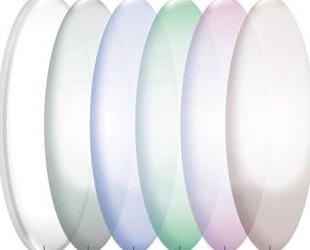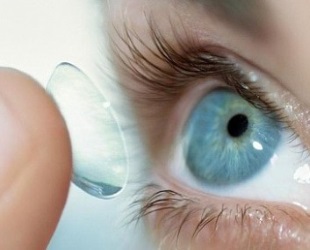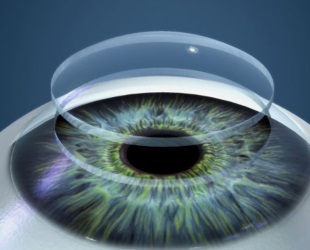
When choosing contact lenses, buyers first of all are guided by whether they are suitable for diopters.
Having made sure that this parameter coincides with their requirements, immediately acquire lenses.
But this is fundamentally wrong. There are no less important parameters that must be taken into account when making this purchase.
One of these parameters is the curvature of the lenses. It is about him that will be discussed in this article.
- 1. What is the curvature of lenses?
- 2. Variants of curvature of
- lenses 3. What is fraught with the wrong choice of the basic curvature?
- 4. How to define it?
- 5. Conclusions
- 6. Video
What is the curvature of lenses?
If contact lenses were prescribed by the ophthalmologist, then in the prescription written by him, in addition to the optical power necessary for the correction of vision, two abbreviations will necessarily be indicated: DIA and BC( sometimes - BS).
The first is the diameter, which sometimes differs on the right and left eye, and the second is the basic curvature of the required lens.
Not everyone knows what it is, however, first of all, it is the curvature that determines the convenience of planting the lens on the cornea of the eye, regardless of whether it is soft or stiff.
The surface of the contact lens is convex from the outer side facing the eyelid, and concave from the inner, immediately adjacent to the eyeball.

Accordingly, the radius of curvature of the lens should coincide with the curvature of the cornea, otherwise the lens will not fit tightly, or, on the contrary, press on the eyeball.
In order to avoid oversight and not to harm your eyes, remember that the basic curvature is measured in millimeters and is indicated on the packaging along with the optical power, and some manufacturers mark on the very surface of the lens.
The smaller the digit indicated by this indicator, the more the surface of the lens is bent more than it is larger - especially the lens is flat.
Curvature variants of lenses
The corneal parameters BC in different people can vary from 7.5 to 9.5 millimeters, and depend on the size and shape of the eye. For example, with pronounced myopia, the cornea becomes more convex, and with keratoconus its surface can very strongly rise above the eyeball itself.
More than 80% of all commercially available contact lenses have a spherical shape and basic curvature, corresponding to the average indicators - from 8.3 to 8.8 millimeters.
That is, it is not difficult to choose the curvatures of the cornea corresponding to its index if it does not go beyond that.
For example, the Acuvue TruEye lenses have a BC of 8.5 to 9.0 mm, with the Optima FW the basic curvature starts at 8.3 and also ends at 9 mm, and the Acuvue Advance and Acuvue 2 can be found in versions from 8.3 to 8, 7 mm.
If, after a visit to the ophthalmologist, it turned out that standard lenses are not suitable, they must be made to order.
But when the difference between available and prescribed by the ophthalmologist lenses is no more than 0.2 mm, their use is permissible: most people in this case do not experience the slightest discomfort.

In addition to contact lenses with spherical curvature, there are also toric-shaped lenses used for astigmatism.
They have two bulges arranged at different angles, and are labeled with two digits indicating the curvature index.
What is fraught with the wrong choice of basic curvature?
Unsuitable lenses cause significant inconvenience when worn:
| Lower than | Higher than |
| If the radius of BC is too low, the lens will slide and shift, irritating the eye and causing lacrimation and itching. Also not enough convex lens can simply fall out of the eye or even damage the cornea. And, of course, due to loose fit, it will not correct the deficiencies of the vision to the full extent. | At too high , the curvature of the inactive and clutching eye is an obstacle to gas exchange and teardrop, dried and hypoxic cornea becomes vulnerable to inflammatory diseases. Unstable vision, eye irritation and lacrimation can also result from the wearing of an excessively convex lens. |
How to define it?

Self-determination of the basic curvature of the cornea is impossible. A simple fitting of the lens will not give an accurate idea of what its performance is.
This is due to the fact that the discomfort caused by improper selection of them can not occur immediately.
In addition, incorrectly selected material and diameter also give unpleasant sensations, and it will be impossible to understand what exactly is wrong with the lenses worn, whether they are not suitable for curvature or for some other reason.
Therefore, in order to learn this characteristic of your eyes, you will need the help of an ophthalmologist.
First of all, a procedure of refractokeratometry is necessary, which will show the parameters of the cornea of the eye. It is painless and takes no more than a few minutes.

Having finished with a preliminary diagnosis and getting an approximate idea of the condition and curvature of the cornea, you can try on the lens and determine the density of its contact with the eye. To do this, after putting on the lens, the doctor conducts the examination with a slit lamp.
In order to make sure that the lens has not sat on the cornea too strongly, fluorescein is injected into the eye - a solution glowing under the ultraviolet lamp.
By the intensity and depth of its penetration under the lens it is not difficult to understand whether its curvature was correctly selected.
Only after this the doctor will be able to prescribe a prescription in which the optical power, diameter and basic curvature of ideally suitable lenses will be accurately indicated. Of course, there are other parameters that are also important for their use: it is an individual reaction to different materials, indicators of softness and rigidity, however, they can not be detected when viewed and here the patient should be guided only by his feelings.
Conclusion
In summary, you should give some advice to those who are just about to start using contact lenses:
- Do not buy lenses without knowing the basic curvature indicator that is right for you,
- Do not try to find out the characteristics of your cornea yourself: this is impossible without a doctor's examination.
- The use of lenses whose BC differs from your reading by no more than 0.2 mm is entirely acceptable, but some can already cause discomfort.
- The use of lenses with a basic curvature significantly different from the curvature of your retina is unacceptable.
Video
The following video is recommended to you:
